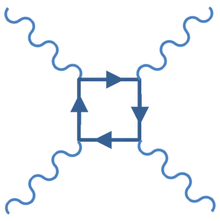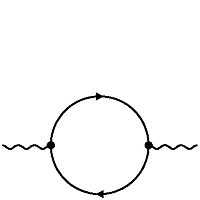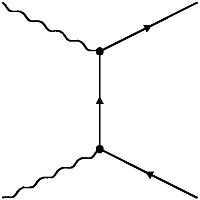Two-photon physics

Two-photon physics, also called gamma–gamma physics, is a branch of particle physics that describes the interactions between two photons. If the energy density of the system of the two photons is large enough, matter can be created.[1]
Astronomy
Photon–photon scattering limits the spectrum of observed gammas to below 80 TeV. The other photon is one of the many photons of the cosmic microwave background. In the frame of reference where the invariant mass of the two photons is at rest, both photons are gammas with just enough energy to pair-produce an electron–positron pair.
Experiments
Two-photon physics can be studied with high-energy particle accelerators, where the accelerated particles are not the photons themselves but charged particles that will radiate photons. The most significant studies so far were performed at the Large Electron–Positron Collider (LEP) at CERN. If the transverse momentum transfer and thus the deflection is large, one or both electrons can be detected; this is called tagging. The other particles that are created in the interaction are tracked by large detectors to reconstruct the physics of the interaction.
Processes
From quantum electrodynamics it can be found that photons cannot couple directly to each other, since they carry no charge, but they can interact through higher-order processes. A photon can, within the bounds of the uncertainty principle, fluctuate into a charged fermion–antifermion pair, to either of which the other photon can couple. This fermion pair can be leptons or quarks. Thus, two-photon physics experiments can be used as ways to study the photon structure, or what is "inside" the photon.


We distinguish three interaction processes:
- Direct or pointlike: The photon couples directly to a quark inside the target photon.[2] If a lepton–antilepton pair is created, this process involves only quantum electrodynamics (QED), but if a quark–antiquark pair is created, it involves both QED and perturbative quantum chromodynamics (QCD).[3][4] The intrinsic quark content of the photon is described by the photon structure function, experimentally analyzed in deep-inelastic electron–photon scattering.[5][6]
- Single resolved: The quark pair of the target photon form a vector meson. The probing photon couples to a constituent of this meson.
- Double resolved: Both target and probe photon have formed a vector meson. This results in an interaction between two hadrons.
For the latter two cases, the scale of the interaction is such as the strong coupling constant is large. This is called Vector Meson Dominance (VMD) and has to be modelled in non-perturbative QCD.
See also
- Channelling radiation has been considered as a method to generate polarized high energy photon beams for gamma–gamma colliders.
- Matter creation
- Pair production
- Neutron gamma gamma
References
- ↑ Moffat JW (1993). "Superluminary Universe: A Possible Solution to the Initial Value Problem in Cosmology". Intl J Mod Phys D. 2 (3): 351–65. arXiv:gr-qc/9211020. Bibcode:1993IJMPD...2..351M. doi:10.1142/S0218271893000246.
- ↑ T.F.Walsh and P.M.Zerwas, "Two photon processes in the parton model", Phys. Lett. B44 (1973) 195.
- ↑ E.Witten, "Anomalous Cross-Section for Photon – Photon Scattering in Gauge Theories", Nucl. Phys. B120} (1977) 189.
- ↑ W.A.Bardeen and A.J.Buras, "Higher Order Asymptotic Freedom Corrections to Photon–Photon Scattering", Phys. Rev. D20 (1979) 166, [Erratum-ibid. D21 (1980) 2041].
- ↑ L3 Collaboration, Measurement of the photon structure function F2γ with the L3 detector at LEP, Phys. Lett. B 622, 249 (2005)
- ↑ R. Nisius, The photon structure from deep inelastic electron photon scattering, Physics Report 332 (2000) 165